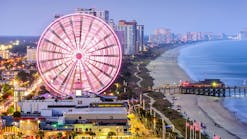About the author:
David Renfrew is vice president and water resources director for Alta Environmental | NV5. Renfrew can be reached at david.renfrew@altaenviron.com. Jacqueline McMillen, P.E., is senior consultant for Alta Environmental | NV5. McMillen can be reached at jacqueline.mcmillen@altaenviron.com.
David Renfrew & Jacqueline McMillen
undefinedWater quality managers may be implementing Best Management Practices (BMPs) using both administrative and structural controls, yet the water quality compliance results still are over permitted limits. Managers may need answers as they report to upper management or regulatory agencies on why BMPs are not performing as expected. Facility and municipal compliance managers need to understand frequent assessment of BMPs is required to evaluate their applicability, effectiveness and maintenance requirements.
This article provides an overview of the considerations water quality managers should make when implementing BMPs and suggests maintenance frequencies often require fine-tuning to ensure BMP functionality. One of the many issues managers face in selecting a BMP is determining how much evaluation is really necessary to determine which BMP to implement. Feasibility studies should be performed but scaled to the appropriate level of the problem at hand. Some solutions are readily identifiable, whereas others are more complex and may need to consider permitting concerns or physical site constraints. Considering finer details and site-specific inputs is critical in selecting a BMP.
Protecting water quality and ensuring compliance are the end goals. Therefore, BMPs should be implemented in an iterative manner, while also ensuring performance is assessed.
Administrative Controls
The key elements of administrative controls are plans, policies and training elements. Insufficient training is the number one element leading to easily controllable problems. Personnel turnover often results in implementation gaps, which can be problematic with new personnel not receiving the appropriate or required training. Annual refresher training for implementation personnel, while not as extensive as initial training, can ensure that key elements are covered and that common problem areas are addressed.
One example is a tiered permit with numeric water quality limits that may require heightened awareness for a given pollutant—aluminum generated from metal manufacturing operations causing water quality exceedances, for example. In this case, more frequent housekeeping actions are required to control the pollutant. Focusing on specific issues with aluminum, in this example, would be an additional message emphasized and communicated in all future training sessions.
Inspections
Inspection frequencies also may need to increase to ensure key problem areas are addressed. For example, if waste-generating areas are consistently observed to have build-up of excess sediment, trash or other pollutants during monthly or quarterly inspections (e.g., with trackout from a rock-crushing operation), the inspection frequency may need to shorten. Additionally, it should be conveyed to staff that more frequent cleaning is required (e.g., weekly, daily or per shift) to reduce compliance risks.
Documenting inspection findings without conveying corrective action or the resolution to the problem prior to the next month's inspection is a common issue in the storm water quality industry. The subsequent inspection then finds repeat issues. This can go on for months or even years, and may result in significant violations or monetary penalties if discovered by regulators. In this scenario, it is critical to perform a frequent audit of the compliance inspections and document when corrective actions are completed.
Structural Controls
Structural BMP controls include both source control or treatment control devices, including storm-resistant shelters, barriers, inlet filters, active or passive treatment systems with filter media and infiltration basins, to name a few. Related challenges include establishing suitability and effectiveness of the devices employed. For example, a site with one discharge point may only need one BMP to be effective. A site with multiple outfalls may require a variety of different BMPs based on the challenges within each drainage area. Further, a BMP that claims to be the end-all device to solve problems should be closely evaluated for efficacy.
While it may be effective in bench scale settings, the site-specific sources and conditions must be assessed prior to selecting a specific BMP. It is common to see treatment systems handle limited influent concentrations, which ultimately need pretreatment controls. These controls ensure they are effective at achieving the desired water quality effluent values desired for the application.
Maintaining Best Management Practices (BMP)
The most common issue with structural BMP devices is the misinterpretation that maintenance only needs to be done once or twice per year. In the water quality world, the "set it and forget it” mentality is far from realistic. Maintenance frequencies must be assessed as soon as a BMP is employed or installed. This only can be done through monitoring of effectiveness, which may include simple visual observations or sampling. For example, an inlet filter or continuous deflective separation (CDS) unit is installed in a high-pollutant generating area and becomes clogged, resulting in bypass after a large storm event. If the device is not inspected or maintained, essentially it is in bypass mode, sending new pollutants downstream between maintenance events.
Verification or effectiveness assessment sampling is another aspect of making sure the BMPs are working. However, getting representative samples is challenging based on how a device is constructed, installed and whether the site is accessible for sampling. In some cases, a pre- and post-BMP sample location will need to be installed. Many BMP device manufacturers now are including a sampling port for collection of a post-filter sample. Caution must be taken, however, as sample locations require proper cleaning, and sampling techniques should be established to ensure representative samples are collected. Sample port tubes can be easily contaminated after the first storm, and subsequent samples taken may indicate the post-filter sample location is actually more contaminated than the filter itself.
It is widely known that the first storm after an extended dry period will produce elevated sample results, or the first-flush. This happens to also be the case with BMPs. Once the first-flush storm occurs, the BMP takes its first hit and begins to degrade in effectiveness. Depending on the size of the first storm, it could be overwhelmed in the first day and then require immediate maintenance or replacement.
With ever more stringent permits—such as California’s Industrial General Permit—BMPs may need to be replaced after each storm event to meet the low Numeric Action Levels (NALs) or ultralow Total Maximum Daily Load (TMDL) values listed in the permit. While this may seem hyper-reactive, actual compliance of potential mandatory minimum penalties for exceedances and more frequent maintenance can avoid future headaches.
Resources on BMP maintenance are available on a variety of online websites. One website titled “Stormwater Best Management Practices Performance Evaluation” is available through the Interstate Technology and Regulatory Council (ITRC) located at www.stormwater-1.itrcweb.org. Another BMP resource is provided by the EPA, located at the following link www.epa.gov/npdes/national-menu-best-management-practices-bmps-stormwater#edu.
In summary, it is highly recommended to perform an annual comprehensive review of a BMP Implementation Plan, if not already required by permit. Knowing where the BMPs are, how they function, their current condition, how and when they are required to be maintained and keeping maintenance records are critical to a successful BMP Implementation Program.






